- Like
- SHARE
- Digg
- Del
- Tumblr
- VKontakte
- Flattr
- Buffer
- Love This
- Save
- Odnoklassniki
- Meneame
- Blogger
- Amazon
- Yahoo Mail
- Gmail
- AOL
- Newsvine
- HackerNews
- Evernote
- MySpace
- Mail.ru
- Viadeo
- Line
- Comments
- Yummly
- SMS
- Viber
- Telegram
- JOIN
- Skype
- Facebook Messenger
- Kakao
- LiveJournal
- Yammer
- Edgar
- Fintel
- Mix
- Instapaper
- Copy Link
 Can the Bowflex Max Trainer Really Get You That Shredded Physique from the Commercials?
Can the Bowflex Max Trainer Really Get You That Shredded Physique from the Commercials?
It’s always best practice to turn a critical eye to the idealized claims touted on fitness infomercials. Bowflex is well-known for flashy commercials showing leaned-out muscular people enjoying getting a great interval-style cardio workout on their products. Is that sweaty grin on their faces warranted by the results you can actually get from the machine?
As a certified personal trainer, I actually do believe the Bowflex Max Trainer home cardio machine has a lot to offer and is a solid investment for those looking to get an intense yet low-impact interval workout without having to leave the privacy of home. Let’s take a look at what the Bowflex Max Trainer is all about, both the positive and negative aspects.
First of all, we’ll briefly go over the health and fitness benefits of intense cardio workouts in general and why you should (or shouldn’t) include them in your fitness plan as the case may be. Then we’ll move on to taking apart the Bowflex Max Trainer itself, including what it does, what kind of workouts you can use it for, who will and who won’t benefit from it, which models are out there, and finally how it compares to other Bowflex home cardio machine options.
Thanks for stopping by, really hope you enjoy my unbiased Bowflex Max Trainer review. Let’s start out by taking a look at what cardio is going to do for your overall fitness, after all, the Max Trainer is all about cardio, right?
Why Do Cardio?
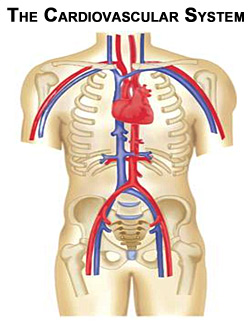 One of the most obvious benefits and most common goals of cardio exercise is weight loss. Cardio activities contribute to your overall calorie burn, and to simplify, the more calories you burn, the more body fat you lose. On some levels, weight loss is a zero sum numbers game: sustain higher calorie burn than calorie intake, and your body will draw needed energy by dismantling fat (and muscle) stores.
One of the most obvious benefits and most common goals of cardio exercise is weight loss. Cardio activities contribute to your overall calorie burn, and to simplify, the more calories you burn, the more body fat you lose. On some levels, weight loss is a zero sum numbers game: sustain higher calorie burn than calorie intake, and your body will draw needed energy by dismantling fat (and muscle) stores.
Other outstanding benefits of regular aerobic exercise include higher bone density, increased high density lipoproteins (HDLs or “good” cholesterol), mood improvement, as well as more energy throughout the day.
Not all cardio is the same. Two basic categories of cardio training can be broken out: steady state cardio and interval cardio. The Max Trainer allows you to execute both styles, but a lot of its advertising and utility centers on intervals (also referred to by the HIIT buzzword going around the fitness world).
How Does Interval Training Work?
 Interval training is nothing fancy, and it’s certainly not exclusive to the Bowflex Max Trainer. It just means alternating bursts of intense activity with lower-intensity recovery periods. Incorporating vigorous high intervals is a great way to burn more calories in less time while improving your cardio recovery and boosting your metabolism.
Interval training is nothing fancy, and it’s certainly not exclusive to the Bowflex Max Trainer. It just means alternating bursts of intense activity with lower-intensity recovery periods. Incorporating vigorous high intervals is a great way to burn more calories in less time while improving your cardio recovery and boosting your metabolism.
Interval training is no joke; the effectiveness of this style of working out is backed by a large body of physiology research. The Bowflex Max Trainer is just one of multitudinous options for adding interval training to your fitness plan. For home cardio options, it happens to be a very solid choice.
A brief note of caution: interval training is best suited for people who are already in decent health and have achieved a baseline level of cardio fitness. Folks with compromised cardiovascular systems, respiratory systems, on certain medications, or who have other health concerns should definitely talk to a doctor before beginning an interval program or any other exercise plan.
What Does the Bowflex Max Trainer Do?
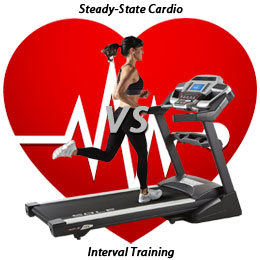
In a nutshell, the Max Trainer makes interval training easy and accessible. Not easy in terms of exertion (oh yes, you’ll work hard on the Max Trainer), but easy in terms of what you need to know (not much) and setup/preparation involved (minimal).
Say you’re used to working out on the elliptical for 30 minutes. You can burn the same amount of calories in 14 minutes on the Bowflex Max Trainer, putting more time back in your day. The Max 14 Interval program takes you through a series of high and low intervals designed to make you work hard and get done fast. If you have more energy and want to burn even more calories, go ahead and do it again! But the idea is that you don’t have to do a ton of cardio to get the same results.
Is this claim legit? Yes, like we talked about above, interval cardio burns more calories in a shorter amount of time because you’re working at a heavy but unsustainable pace during those high intervals. Intervals are also better for building and keeping muscle mass than longer, steady-state cardio, so good news for lifters like myself that want to take care of fat loss and cardio health needs without wasting away strength gains.
What Makes the Bowflex Max Trainer Stand Out?
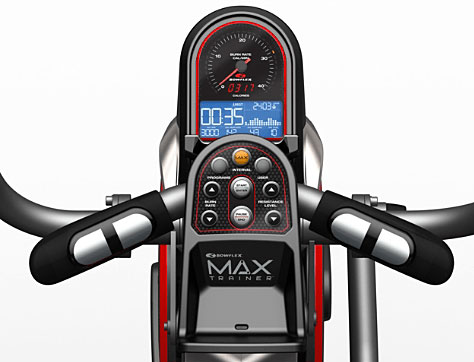
A major feature of the Max Trainer is that you get to recruit your upper body muscles almost twice as much as you can on the average elliptical, adding to your overall calorie burn. Additionally, you’ll strengthen and tone your chest and arms alongside your glutes and legs. This is a unique feature of the Max Trainer that other cardio machines don’t offer to such a high degree, making it definitely stand out from the crowd if you’re into efficiency.
Another key benefit is its tiny footprint. Its compact, space-saving design takes up less than than the floor space of your average home treadmill. It’s also elevated slightly off the floor, so it’s easy to clean around and under if you have messy kids or pets. My cat’s hair used to form a nasty, hard-to-remove “snowdrift” under my treadmill: not a problem with a Max Trainer.
Also, the Max Trainer’s interface makes it very clear what intensity level you need to hit with a dynamic readout that includes rate of calorie burn (as a trainer, I have to tell you that no cardio machine is 100% accurate on calorie estimates, as there is variation between individuals in terms of body size, metabolic rate, hormone balance, etc, etc, etc). But having a needle move to tell you when to amp it up or back it off helps you ballpark where you need to be instead of guessing. The visual also helps you stay motivated. For the techies and social media addicts, the interface is also syncable with your smartphone (iOS or Android) so you can log, track, and share your workouts and progress over time. The Max Trainer App is only available for Models M5 and M7, not for the basic M3 model.
Finally, I like that you can get the intensity needed to really get the most out of intervals while keeping your workout super low-impact. When running intervals, yeah, you get a lot of calorie burn, but you get a lot of bang bang bang on your joints, which can contribute to overuse injuries or exacerbate ongoing underlying problems. The Max Trainer is more sustainable, and actually burns more calories than running intervals because you get to use your glutes and upper body so much more.
What Kind of Workouts Can You Do on the Max Trainer?
The whole point of the Max Trainer is to do interval workouts. You can follow the Max 14 Interval Workout, or you can adjust your intervals manually. If you’re not feeling intervals any given day, you can hit steady-state to get a good burn going for your legs and glutes as you work on your cardio endurance. The basic M3 model allows both Max 14 Interval mode and manual mode, while the more fancy M5 and M7 models add lots of different built-in programs as well as additional resistance options (8, 16, and 20 resistance options respectively for the M3, M5, and M7). Before we get too excited going over the different model options, let’s discuss whether or not the machine is a good choice for you as an individual.
Who Is the Bowflex Max Trainer Suited For?
If you’re in good health and free of any major hip, knee, or back problems, the Max Trainer should be safe for you. Since it’s allows you to exercise vigorously with pretty much zero impact, it should help keep you healthy and injury-free too. If you are in good health but poor fitness at the moment, start slow with the Max Trainer. Ease into it rather than hitting the high resistance right away. Be sure to do a light warmup first. It will help to stretch your hips, hamstrings, and quads before starting, because the Max Trainer asks you to take step through a pretty good range of motion. The Max Trainer is also only suitable for those of you with deep pocket books, this baby is expensive! However, if you have the money to spare and want the ultimate stacked home gym, this machine will fit the bill for your cardio needs.
Who is the Bowflex Max Trainer NOT Suited For?
If you have significant hip, knee, or back problems, or trouble taking high steps, there are better options out there than the Max Trainer. Additionally, if you have health concerns that preclude your ability to do intense cardio, again, the Max Trainer is not the safest choice for you. If any aspects of the above description sound a lot like you, I’d recommend looking into the Bowflex TreadClimber, a Concept2 Rower, a Schwinn Airdyne Stationary Bike, or even just a simple home treadmill. Again, when in doubt, ask your doctor for advice rather than taking the risk! Finally, if you have a limited budget, the Bowflex is not going to be a great option for you because of it’s hefty price. This is unfortunate because it is a great cardio machine.
Bowflex Max Trainer or TreadClimber?
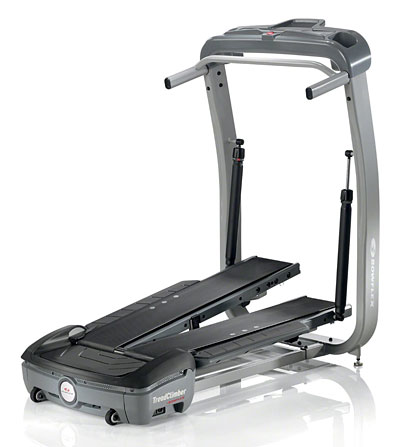
Let’s say you’re shopping through the selection of Bowflex home cardio equipment options. There are two main categories you’ll be looking at: the Bowflex Max Trainer and the Bowflex TreadClimber. Which one is best? Well, they both prove to be quality products, and there are benefits to both. Which type of cardio machine is best for you depends on a few factors: your fitness level, how intensely you want to be able to work out, and your history of injuries or biomechanical issues.
If you’re someone like me who wants their cardio workouts quick, intense, and dripping in sweat, I would recommend the Max Trainer over the TreadClimber. While the TreadClimber is best suited to more extended, slow-paced hill-walking cardio, the Max Trainer is built for vigorous interval training. Using the Max Trainer means you are able to burn more calories in less time compared the the TreadClimber. So if you’re a busy person who works full time, takes care of your family, or fills both roles, the Max Trainer will treat you right. You don’t have to carve out a ton of your time to get a lot done.
However, if you are brand-new to exercise, have a history of injuries, joint problems, or biomechanical issues, a better choice would be the TreadClimber. This machine is also more friendly to people who just prefer less intense exercise (after all, the TreadClimber slogan is “Just Walk”). Maybe you like to work out while polishing off the back catalog of Property Brothers. No judgement. Just know that you’ll have to spend more time on the TreadClimber to burn an equivalent amount of calories (i.e., body fat) than you would on the more efficient Max Trainer.
Further Reading:
How Do the Different Max Trainer Models Stack Up?
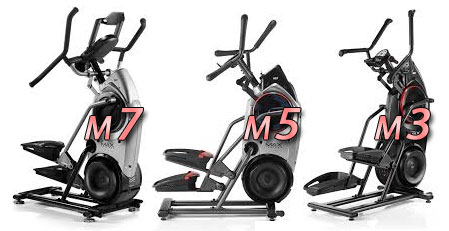
Again, the best choice among the Max Trainer model options depends more on you than on the machine. While the models are similar in concept, there are a few key differences that can help guide your choice. All of the models are essentially the same dimensions, making each one pretty much equally compact and space-friendly (46” Length x 25-29.4” Width x 63-65” Height); each model includes an AC adapter to plug into the wall as a power source, as well as a handy water bottle holder. Going forward, the differences begin to stack up. Let’s break down the variations between the three popular Max Trainer models: the M7, M5, and M3.
The M3 is the most basic and inexpensive Max Trainer. Features include 8 resistance levels, 14 minute interval mode or manual mode, chest strap to monitor heart rate, standard pedals, 2 user profiles, standard LCD screen, and a one year warranty. In all the descriptions preceding this, unless otherwise noted, I have been talking about basic functionality of any Max Trainer, so the M3 sets the standard while the M5 and M7 include upgrades to what we have already talked about.
Moving onto the mid-range M5, we’re looking at a higher price tag along with significantly upgraded features. Instead of 8 resistance modes, you’ll have 16 choices of resistance. The foot pedals and grips are higher quality, and you can monitor your heart rate on the grip contacts instead of just the chest strap. The program options also expand: you can now choose between 14 minute interval, Power Interval, Calorie Goal, Steady Pace, Fat Burn, Calorie Burn, Stairs, Fitness Test, as well as the manual mode. The display is now backlit LCD, and the warranty is extended to two years. A new feature is the nifty Max Trainer App (Android and iOS compatible, Bluetooth-syncing), which allows you to track progress, get coaching suggestions, and share via social media channels.
At the top of the pile is the M7, the newest, most feature-heavy, and priciest option. The Max Trainer M7 is considered commercial grade, being the model designed to sustain the heaviest use. You now have 20 levels of resistance to choose from, as well as more programs: 7 Min Interval, 14 Min Interval, 21 Min Interval, Power Interval, Stairs, Calorie Goal, Steady Pace, Fat Burn, Calorie Burn, Fitness Test, and of course Manual. The grips are expanded and improved, as well as the pedals. There’s a taller, upgraded media shelf. You’ve got an higher-tech dual mode backlit LCD screen, and can now have 4 custom user profiles rather than two, making the M7 the most family-friendly model; the upgraded durability and the three year warranty help that cause too. And let’s be honest, the M7 looks the coolest.
OK, So….Which Max Trainer Model is Best?
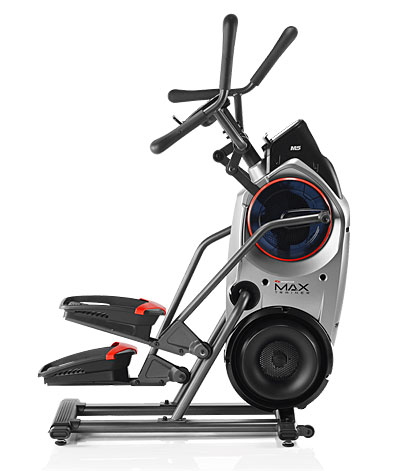 Full disclosure: I have only tried two of the three models (the M3 in a client’s home and used the M7 in my friend’s training studio). Choosing for myself, I’d recommend the M7 if it’s within your budget. I like to have the option of different interval lengths, and the higher-quality construction is noticeable, which really appeals to me. And like I said…it looks the coolest, which is a not-insignificant consideration if it’s going to be in a high-traffic area of your home.
Full disclosure: I have only tried two of the three models (the M3 in a client’s home and used the M7 in my friend’s training studio). Choosing for myself, I’d recommend the M7 if it’s within your budget. I like to have the option of different interval lengths, and the higher-quality construction is noticeable, which really appeals to me. And like I said…it looks the coolest, which is a not-insignificant consideration if it’s going to be in a high-traffic area of your home.
If your home gym budget is a little tighter, or you just want something with standard functionality rather than a bunch of different program options, the M3 will suit your needs just fine. You can always adjust manually to take yourself through different interval schemes. Bottom line: you can get a great interval workout on any of these machines, so I wouldn’t advise against any of them.
Bowflex Max Trainer Review: The Trainer’s Takeaway
Among cardio equipment for home gyms or small training studios, the Max Trainer is an excellent option if spending a minimum of a few thousand bucks is within your budget. The top-end M7 is obviously the nicest, but the basic M3 is still well-built and worthwhile. The M3 is also substantially cheaper than the highest-end model which makes it a more realistic purchase for many of us. The M5 naturally falls somewhere in the middle when it comes to price and features.
All models are super-compact compared to many other cardio machine options, which makes them especially appealing for small spaces.
You get to use your full body rather than just legs (higher calorie burn), and glute recruitment is high (meaning you burn a lot of calories while it’s also fantastic for toning the booty and thighs).
If intense, shorter duration, sweaty as all-get-out workouts are what you’re into, I think you’ll be really satisfied with what the Max Trainer has to offer.
Thank you for reading my Bowflex Max Trainer review! Let me know in the comments below if you’ve ever tried the Max Trainer out yourself and what you think about it. Would love your feedback!
See Also:
About Michael Behnken
Mike Behnken is a personal trainer who holds multiple NASM certifications and a MS in Exercise Science. Mike loves fitness, travel, and photography among many other interests.

